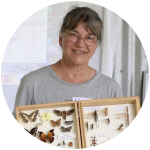Welcome and Introduction
They left the water, conquered the land, and took to the skies. They can be friends: providing invaluable pollination and nutrient recycling ecosystem services, but they can be foes: pest species can sometimes reach plague proportions. Some are masters of disguise, while others flaunt their spectacular beauty. Insects are undoubtedly the most successful animal group, in diversity, geography and ecology. They are also a rich part of our environment, economy and culture.
THRD0023 001 (YouTube, 2m 41s):
Welcome to Insect Science! This open-access textbook is an introductory guide to entomology, and forms the main resource for students enrolled in BIOL2205 Insect Science at The University of Queensland. This is a course for the budding entomologist and will train you in professional entomological skills: (1) insect identification, (2) specimen preparation, (3) advanced microscopy, and (4) communication.
For our students, by the end of the course you should be able to:
- Understand the significance of insects in environmental, economic, and social contexts
- Characterise (identify) an insect specimen to the Order and Sub-Order taxonomic level
- Prepare insect specimens for the purposes of insect identification to a professional standard
- Read and appraise entomological literature critically
The course is delivered by the authors of this textbook.
 Dr Gurion Ang
Dr Gurion Ang
My curiosity for insects did not begin until university, where I learnt about the weird and whimsical diversity of insects and plants. My PhD was dedicated to better understanding the tritrophic interaction between the diamondback moth Plutella xylostella and small cabbage white butterfly Pieris rapae, specialist herbivores of cabbage plants, and their parasitic natural enemies including the wasps Diadegma semiclausum and Cotesia glomerata.

Dr Kathryn (Kathy) Ebert
I’ve always been passionate about natural history and sharing that passion with others. Insects provide a never ending source of amazement with their incredible diversity of behaviours and forms! For my PhD, I focussed on Australian native dung beetles, in particular, the unusual behaviour, diet and microbiome of the rainforest dung beetle, Cephalodesmius.
The success of Insect Science builds on the legacy and passion of phenomenal entomologists. We acknowledge their contributions.
- Gordon Gordh
- Margaret Schneider
- Bronwen Cribb
- David Merritt
We would also like to acknowledge the following people for sharing their fantastic insect photos, all of whom are past students of the course or have been a keen supporter of UQ entomology in some way:
- Will Arnold
- Lyn Cook
- James Dorey
- Colleen Foelz
- Andrew Maynard
- Anthony O’Toole
- Jessa Thurman
- James Tweed

